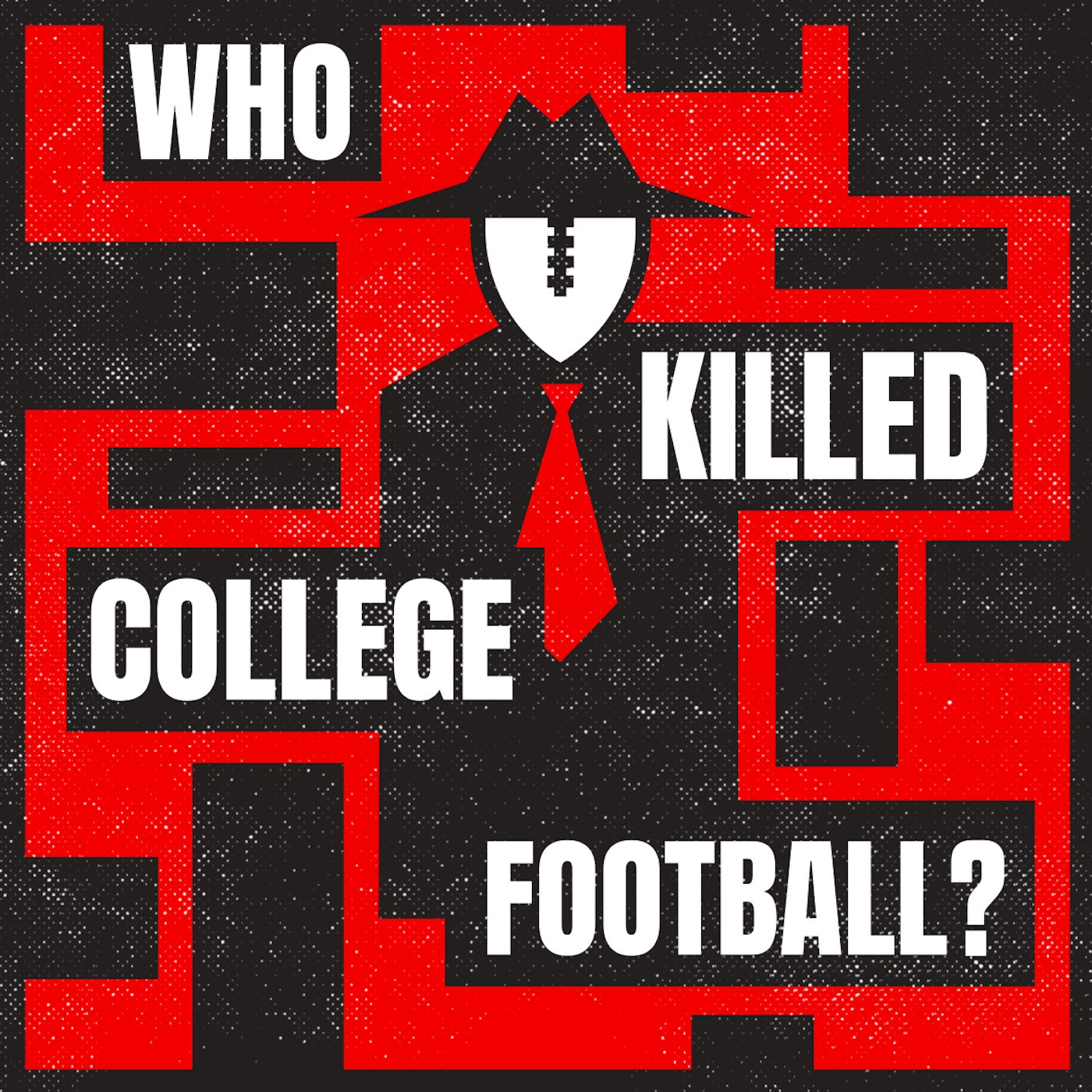Discover Who Killed College Football?
Who Killed College Football?

Who Killed College Football?
Author: Steven Godfrey and Ryan Nanni
Subscribed: 60Played: 871Subscribe
Share
© Ryan Nanni
Description
College football has undergone radical, sometimes alarming changes in recent years, and this show explores the motives, history, and power behind six different suspects who have reshaped an American sport right before our eyes.
wkcfb.substack.com
wkcfb.substack.com
16 Episodes
Reverse
This is a free preview of a paid episode. To hear more, visit wkcfb.substack.comThe epilogue may be out, but Steven and Ryan are not done reviewing questions submitted by the wise and learned paid subscribers to the Who Killed College Football Substack. A free preview of the episode is available to everyone, but if you’d like to unlock the full episode and be able to submit questions of your own for future mailbags, become a paid s…
We’ve looked at six different parties who have shaped the direction of college football over the last fifty years (or longer): television, conferences, the NCAA, the NFL, coaches & agents, and the government. So now it’s time to ask a few tough questions. Are any of those six directly and solely responsible? Is college football actually dead or dying? And why won’t Nick Saban sit down to chat with Steven Godfrey?Producer: Michael HenahanResearcher: Alex McDaniel This is a public episode. If you’d like to discuss this with other subscribers or get access to bonus episodes, visit wkcfb.substack.com/subscribe
From Richard Nixon to the United States Senate to the Virginia Governor’s Office to the California Board of Regents to the Supreme Court of the United States, college football has been subject to grandstanding, criticism, and scrutiny at all levels of government. But can our nation’s elected institutions (or its courts) actually solve the sport’s problems, and do they even have the ability to do so?Producer: Michael HenahanResearcher: Alex McDaniel This is a public episode. If you’d like to discuss this with other subscribers or get access to bonus episodes, visit wkcfb.substack.com/subscribe
This is a free preview of a paid episode. To hear more, visit wkcfb.substack.comSteven and Ryan tackle questions from paid subscribers to the Who Killed College Football Substack community about Suspect Number Five: Coaches and Agents. A free preview of the episode is available to everyone, but if you’d like to unlock the full episode and be able to submit questions of your own for future suspects, become a paid subscriber today!
From its earliest days, college football has had a tense relationship with players and money. But it wasn’t until the market for coaches started exploding that the gulf between what coaches earn and what players cannot really started to look outlandish. Agents, of course, helped usher the age of absurdity in, by winning contract terms that gave their clients more and more, even if they weren’t successful. As their pay skyrocketed, coaches were mostly silent about structural issues popping up in the sport, and for good reason: the status quo was entirely too good to overturn.Producer: Michael HenahanResearcher: Alex McDaniel This is a public episode. If you’d like to discuss this with other subscribers or get access to bonus episodes, visit wkcfb.substack.com/subscribe
This is a free preview of a paid episode. To hear more, visit wkcfb.substack.comSteven and Ryan sit down once again to review questions from the paid subscriber community on Substack, this time about Suspect Number Four: The National Football League. A free preview of the episode is available to everyone, but if you’d like to unlock the full episode and be able to submit questions of your own for future suspects, become a paid subs…
Once upon a time, the NFL shaped its Draft policies (and date) around not angering college football. The power and popularity of The Shield have increased dramatically over the last four or five decades, but the league spent many of those years keeping underclassmen out as a default, and it took years of pressure from players like Barry Sanders, Cris Carter, and Herschel Walker to eventually open up a pro pathway for juniors. Why has the NFL shied away from taking on college football, and what has it meant to the college game to keep players trapped in one system for most of the sport’s history?Producer: Michael HenahanResearcher: Alex McDaniel This is a public episode. If you’d like to discuss this with other subscribers or get access to bonus episodes, visit wkcfb.substack.com/subscribe
This is a free preview of a paid episode. To hear more, visit wkcfb.substack.comAs we do after every suspect is revealed and investigated, we turned it over to the paid members of the Who Killed College Football Substack community to interrogate us about the NCAA episode. Topics include why the Association and its members failed to plan for the future, the death penalty vs. just kicking a school out of the NCAA altogether, and what…
The NCAA spent the better part of 70 years stamping out threats to amateurism wherever they could find them. From big scandals to seemingly minor violations, the Association was there to defend the idea that college football shouldn’t be about money, at least for the players. For a while, the courts, media, and public opinion all backed them up. But as the riches in the sport grew, the NCAA became something of a comic villain, and when the time came for college football’s relationship with labor to evolve, the NCAA never seemed ready to lead the charge.Producer: Michael HenahanResearcher: Alex McDaniel This is a public episode. If you’d like to discuss this with other subscribers or get access to bonus episodes, visit wkcfb.substack.com/subscribe
This is a free preview of a paid episode. To hear more, visit wkcfb.substack.comR. Bowen Loftin served as president of Texas A&M from 2010 to 2014. He also appeared in our Conferences episode, discussing the influence the Longhorn Network had on Texas A&M’s decision to head to the SEC. But he had more to share about life in the old Big 12, including some revelations about the Governor’s office and the reality of the conference’s po…
This is a free preview of a paid episode. To hear more, visit wkcfb.substack.comAs we do after each suspect, we took questions from the paid members of the WKCFB Substack community about the conferences episode. (Temple is mentioned twice here, to give you a sense of how winding this gets.) A free preview of the episode is available to everyone, but if you’d like to unlock the full episode and be able to submit questions of your ow…
Conferences didn’t used to be where all the bargaining power resided in college football, and their concerns used to be exceedingly local. Today, they’re conglomerates locked into escalating wars of spending and revenue, and leaning on their market strength (or weakness) to shape everything from the postseason to realignment. They’ve even found a way to make that business competition important to fans, and the conferences have no reason to slow down now.Producer: Michael HenahanResearcher: Alex McDaniel This is a public episode. If you’d like to discuss this with other subscribers or get access to bonus episodes, visit wkcfb.substack.com/subscribe
This is a free preview of a paid episode. To hear more, visit wkcfb.substack.comAfter we review each suspect in our college football murder mystery, we’ll be taking questions from paid members of the WKCFB Substack community about that episode – what went into making it, topics we didn’t cover, questions about the history we laid out, whatever. We got some great questions after the TV episode and enjoyed batting them around.If you…
College football’s rise as a valuable TV product is still relatively new. For decades, the sport either couldn’t be televised or was limited at a national level. But once that market opened up, networks moved fast to get more of everything – more games, more bowls, more playoffs. They’re not just broadcast partners either. These companies have found a way to acquire partial ownership of college football, becoming business partners with conferences. Thanks to television, it’s easier than ever to watch almost every game at the FBS level. It’s also a lot harder to tell what that level’s going to look like in the future.Producer: Michael HenahanResearcher: Alex McDaniel This is a public episode. If you’d like to discuss this with other subscribers or get access to bonus episodes, visit wkcfb.substack.com/subscribe
Before we dive into the six suspects in the death of college football, let’s begin with a confession. College football is, in fact, very much alive, with upsets being sprung, conferences continuing to realign, and expanded playoff spots to fret over. The sport remains incredibly popular, entertaining, and, at least for certain segments, financially lucrative.But the college football you used to know? That might be dead, whether you’re unhappy about the slow erasure of amateurism, swollen superconferences disregarding geography, the power of television networks to shape the future, and any number of other changes that could shake your belief in what college football was, is, or should be.If you’re feeling that way, well, so is Nick Saban. So let’s start digging into how we got here in the first place.Producer: Michael HenahanResearcher: Alex McDaniel This is a public episode. If you’d like to discuss this with other subscribers or get access to bonus episodes, visit wkcfb.substack.com/subscribe
Coming soon: Steven Godfrey and Ryan Nanni attempt to find out Who Killed College Football? in a six-part series examining the major power players who have wreaked so much havoc on the sport This is a public episode. If you’d like to discuss this with other subscribers or get access to bonus episodes, visit wkcfb.substack.com/subscribe
Top Podcasts
The Best New Comedy Podcast Right Now – June 2024The Best News Podcast Right Now – June 2024The Best New Business Podcast Right Now – June 2024The Best New Sports Podcast Right Now – June 2024The Best New True Crime Podcast Right Now – June 2024The Best New Joe Rogan Experience Podcast Right Now – June 20The Best New Dan Bongino Show Podcast Right Now – June 20The Best New Mark Levin Podcast – June 2024
 United States
United States









I was really struggling with my coursework, so I decided to try a do my coursework service. I am so glad I did. The process was smooth, and the work they delivered was exactly what I needed. If you want to know more about this service then go here https://ukwritings.com/do-my-coursework It not only saved my time but also gave me confidence knowing I was not handing in anything wrong. If you are feeling overwhelmed, this is definitely worth considering for some much-needed support.